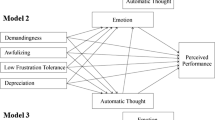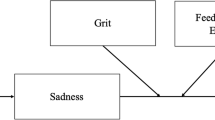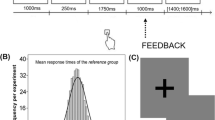Abstract
Following the logic of a prior experiment (Seligman et al., 1990) with varsity collegiate swimmers, sixty student volunteers performed a brief, but highly stressful vigilance task. Half were then given false feedback indicating poor performance; the others experienced a non-evaluative display at that point. All were then asked to repeat the vigil. Half the observers were assessed as high optimists and half as high pessimists. The pessimists showed a steeper vigilance decrement than the optimists, consistent with a model (Scheier and Carver, 1987) that proposes that pessimists are more emotion-focused under stress than optimists, and hence would be less attentive to the vigilance display, regardless of feedback condition. The false negative feedback actually turned out to be ineffective; hence, based on Seligman's account of the swimmer study, which requires effective negative feedback, there should have been no vigilance performance difference between optimists and pessimists, either pre- or post-feedback.
Similar content being viewed by others
References
Abramson, L.Y., Seligman, M.E.P., and Teasdale, J.D. (1978). Learned helplessness in humans: Critique and reformulation. Journal of Abnormal Psychology, 87,49–74.
Alluisi, E.A. (1969). Sustained performance. In E.A. Bilodeau and I.M. Bilodeau (Eds.), Principles of skill acquisition (pp. 59–102). New York, NY: Academic Press.
Becker, A., Warm, J.S., and Dember, W.N. (1994). Specific and nonspecific transfer effects in training for vigilance. In M. Mouloua and R. Parasuraman (Eds.), Human performance in automated systems: Current research and trends (pp. 294–299). Hillsdale, NJ: Lawrence Erlbaum Associates.
Berch, D.B. and Kanter, D.R. (1984). Individual differences. In J.S. Warm (Ed.), Sustained attention in human performance (pp. 143–170). New York: John Wiley and Sons.
Coren, S., Ward, L.M., and Enns, J.T. (1999). Sensation and perception (5th ed.), Fort Worth, TX: Harcourt-Brace.
Craig, A. (1984). Human engineering: The control of vigilance. In J.S. Warm (Ed.), Sustained attention in human performance (pp. 247–292). New York: John Wiley and Sons.
Davies, D.R. and Parasuraman, R. (1981). The psychology of vigilance. London, UK: Academic Press
Dember, W.N. and Brooks, J. (1989). A new instrument for measuring optimism and pessimism: Test-retest reliability and relations with happiness and religious commitment. Bulletin of the Psychonomic Society, 27, 365–366.
Dember, W.N., Martin, S.H., Hummer, M.K., Howe, S.R., and Melton, R.S. (1989). The measurement of optimism and pessimism. Current Psychology: Research and Reviews, 8,102–119.
Dember, W.N. and Warm, J.S. (1979) Psychology of perception (2nd ed.). New York: Holt, Rinehart & Winston.
Dittmar, M.L., Warm, J.S., and Dember, W.N. (1985). Effects of knowledge of results on performance in successive and simultaneous vigilance tasks: A signal detection analysis. In R.E. Eberts and C.G. Eberts (Eds.), Trends in ergonomics/human factors II (pp. 195–202). New York, NY: North-Holland.
Galinsky, T.L., Rosa, R.R., Warm, J.S., and Dember, W.N. (1993). Psychophysical determinants of stress in sustained attention. Human Factors, 35,603–614.
Hancock, P.A. and Warm, J.S. (1989). A dynamic model of stress and sustained attention. Human Factors, 31, 519–537.
Howell, W.C. (1993). Engineering psychology in a changing world. Annual Review of Psychology, 44, 231–263.
Hiroto, D.S. (1974). Locus of control and learned helplessness. Journal of Experimental Psychology, 102, 187–193.
Huey, B.M. and Wickens, C. (1993). Summary. In B.M. Huey and C. Wickens (Eds.) Workload transition: Implications for individual and team performance, (pp. 1–12). Washington D.C.: National Academy Press.
Hummer, M.K., Dember, W.N., Melton, R.S., and Schefft, B.K. (1992). On the partial independence of optimism and pessimism. Current Psychology: Research and Review, 11, 37–50.
Koelega, H.S. (1992). Extroversion and vigilance performance: 30 years of inconsistencies. Psychological Bulletin, 112, 239–258.
Lazarus, R.S. and Folkman, S. (1984). Stress, appraisal, and coping. New York: Springer.
Lewis, L.M., Dember, W.N., Schefft, B.K., and Radenhausen, R.A. (1995). Can experimentally induced mood affect optimism and pessimism scores? Current Psychology: Research and Review, 14, 29–41.
Mackworth, J. (1970). Vigilance and attention. Baltimore, MD: Penguin Books.
Matthews, G., Joyner, L., Gilliland, K., Huggins, J., and Falconer, S. (1999). Validation of a comprehensive stress state questionnaire: Towards a state big three? In I. Merville, I.J. Deary, F. DeFruyt, and F. Ostendorf (Eds.), Personality psychology in Europe (vol. 7) pp. 335–350. Tilburg: Tilburg university Press.
McGrath, J.E. (Ed.). (1970). Social and psychological factors in stress. New York: Holt, Rinehart and Winston, Inc.
Mineka, S., Pury, C.L., and Luten, A.G. (1995). Explanatory style in anxiety and depression. In G.M. Buchanan and M.E.P. Seligman (Eds.), Explanatory style, (pp. 135–158). Mahwah, NJ: Lawrence Erlbaum Associates.
Nachreiner, F. (1977). Experiments on the validity of vigilance experiments. In R. Mackie (Ed.), Vigilance: Theory, operational performance and physiological correlates (pp. 665–678). New York, NY: Plenum Press.
Natali-Alemany, R. (1991). Moods, coping, and perception of daily life events: Are these factors related to optimism and pessimism? Unpublished doctoral dissertation, University of Cincinnati.
Parasuraman, R. (1986). Vigilance, monitoring, and search. In: K.R. Boff, L. Kaufman, and J.P. Thomas (Eds.), Handbook of perception and human performance, Vol II: Cognitive processes and performance (pp. 431–439). New York: Wiley.
Peterson, C, Buchanan, G.M., and Seligman, M.E.P. (1995). Explanatory style: History and evolution of the field. In G.M. Buchanan and M.E.P. Seligman (Eds.), Explanatory style (pp. 1–20). Mahwah, NJ: Lawrence Erlbaum Associates.
Reilley, S., Geers, A.L., Lindsay, D.L., Dember, W.N., and Schafer, J. (1998). Disentangling the importance of different optimism-pessimism instruments: Research issues and implications. Poster presented at the meeting of the American Psychological Society, Washington DC.
Sansone, C. and Harackiewicz, J.M. (1998). “Reality” is complicated. American Psychologist, 53, 673–674.
Satchel, P. (1993). Cockpit monitoring and alerting systems. Cambridge, UK: Ashgate.
Scerbo, M.W. (1998). What's so boring about vigilance. In R.R. Hoffman, M.F. Sherrick and J.S. Warm (Eds.), Viewing psychology as a whole: The integrative science of William N. Dember (pp. 145–166). Washington, DC: American Psychological Association.
Scheier, M.F. and Carver, C.S. (1985) Optimism, coping, and health: Assessment and implications of generalized outcome expectancies. Health Psychology, 4, 219–247.
Scheier, M.F. and Carver, C.S. (1987) Dispositional optimism and physical well-being: The influence of generalized outcome expectancies on health. Journal of Personality, 55,170–210.
Seligman, M.E.P., Abramson, L., Semmel, A., and von Baeyer, C. (1979). Depressive attributional style. Journal of Abnormal Psychology, 88, 242–247.
Seligman, M.E.P., and Maier, S.F. (1967). Failure to escape traumatic shock. Journal of Experimental Psychology, 94, 1–9.
Seligman, M.E.P., Nolen-Hoeksema, S., Thornton, N., and Thornton, K. (1990). Explanatory style as a mechanism of disappointing athletic performance. Psychological Science, 1,143–146.
Seligman, M.E.P. and Schulman, P. (1986). Explanatory style as a predictor of productivity and quitting among life insurance sales agents. Journal of Personality and Social Psychology, 50, 832–838.
Temple, J.G., Warm, J.S., Dember, W.N., LaGrange, CM., and Matthews, G. (1996). Performance, workload, and stress in an abbreviated vigilance task. Poster presented at the meeting of the Psychonomic Society, Chicago, IL.
Temple, I.G., Dember, W.N., Warm, J.S., Jones, K.S., and LaGrange, C.M. (1997). The effects of caffeine on performance and stress in an abbreviated vigilance task. Proceedings of the Human Factors and Ergonomics Society, 40,1293–1297.
Tennen, H. and Eller, S.J. (1977). Attributional components of learned helplessness facilitation. Journal of Personality and Social Psychology, 35, 265–271.
Warm, J.S. (Ed.) (1984). Sustained attention in human performance. Chichester, UK: Wiley.
Warm, J.S. (1993). Vigilance and target detection. In B.M. Huey and C. Wickens (Eds.) Workload transition: Implications for individual and team performance (pp. 139–170). Washington D.C: National Academy Press.
Warm, J.S. and Dember, W.N. (1998). Tests of vigilance taxonomy. In R.R. Hoffman, M.F. Sherrick, and J.S. Warm (Eds.), Viewing psychology as a whole: The integrative science of William N. Dember (pp. 87–112). Washington, D.C: American Psychological Association.
Warm, J.S. and Jenson, H.J. (1984). The psychophysics of vigilance. In J.S. Warm (Ed.), Sustained attention in human performance (pp. 15–59). Chichester, UK: Wiley.
Zullow, H.M. (1995). Pessimistic rumination in American politics and society. In G.M. Buchanan and M.E.P. Seligman (Eds.), Explanatory style (pp. 187–208). Mahwah, NJ: Lawrence Erlbaum Associates.
Author information
Authors and Affiliations
Rights and permissions
About this article
Cite this article
Helton, W.S., Dember, W.N., Warm, J.S. et al. Optimism, pessimism, and false failure feedback: Effects on vigilance performance. Curr Psychol 18, 311–325 (1999). https://doi.org/10.1007/s12144-999-1006-2
Accepted:
Issue Date:
DOI: https://doi.org/10.1007/s12144-999-1006-2




